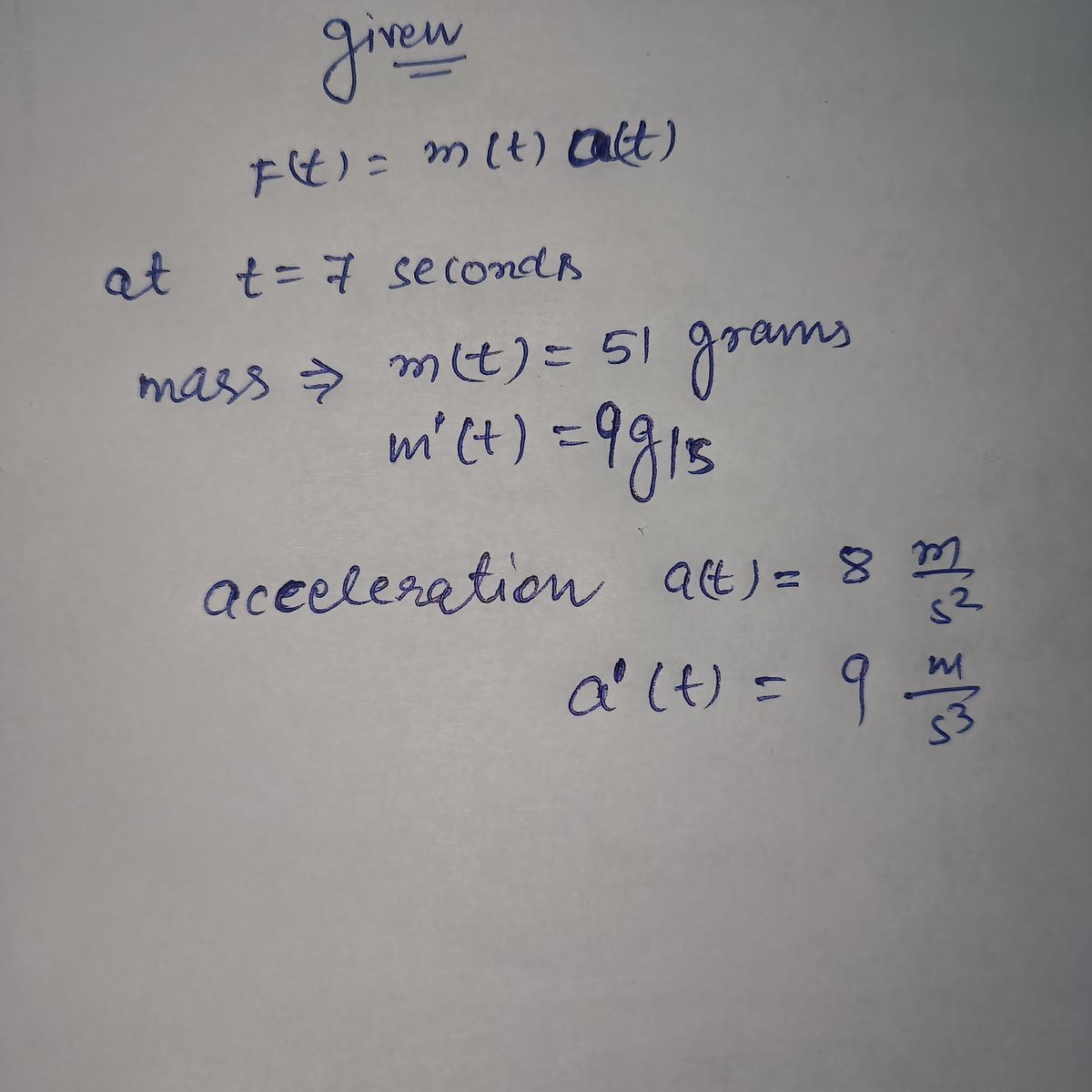The force F on an object is the product of the mass m and the acceleration a. In this problem, assume that the mass and acceleration both depend on time t, hence so the does the force. That is, F(t) = m(t)a(t) At time t = 7 seconds, the mass of an object is 51 grams and changing at a rate of 9. At this same time, the acceleration is 8 and changing at a rate of 9 By the product rule, the force on the object is changing at the rate of Please include units in your answer (click the link for help).. To enter compound units use multiplication, division, and exponent symbols, e.g., use ft * lb for foot-pounds or m/s² for meters per second per second.
The force F on an object is the product of the mass m and the acceleration a. In this problem, assume that the mass and acceleration both depend on time t, hence so the does the force. That is, F(t) = m(t)a(t) At time t = 7 seconds, the mass of an object is 51 grams and changing at a rate of 9. At this same time, the acceleration is 8 and changing at a rate of 9 By the product rule, the force on the object is changing at the rate of Please include units in your answer (click the link for help).. To enter compound units use multiplication, division, and exponent symbols, e.g., use ft * lb for foot-pounds or m/s² for meters per second per second.
Calculus: Early Transcendentals
8th Edition
ISBN:9781285741550
Author:James Stewart
Publisher:James Stewart
Chapter1: Functions And Models
Section: Chapter Questions
Problem 1RCC: (a) What is a function? What are its domain and range? (b) What is the graph of a function? (c) How...
Related questions
Question

Transcribed Image Text:The force F on an object is the product of the mass m and the acceleration a. In this problem, assume that the
mass and acceleration both depend on time t, hence so the does the force. That is,
F(t) = m(t)a(t)
At time t = 7 seconds, the mass of an object is 51 grams and changing at a rate of 9. At this same time, the
acceleration is 8 and changing at a rate of 9.
By the product rule, the force on the object is changing at the rate of
Please include units in your answer (click the link for help).. To enter compound units use multiplication, division,
and exponent symbols, e.g., use ft * lb for foot-pounds or m/s² for meters per second per second.
Expert Solution
Step 1

Trending now
This is a popular solution!
Step by step
Solved in 3 steps with 3 images

Recommended textbooks for you

Calculus: Early Transcendentals
Calculus
ISBN:
9781285741550
Author:
James Stewart
Publisher:
Cengage Learning

Thomas' Calculus (14th Edition)
Calculus
ISBN:
9780134438986
Author:
Joel R. Hass, Christopher E. Heil, Maurice D. Weir
Publisher:
PEARSON

Calculus: Early Transcendentals (3rd Edition)
Calculus
ISBN:
9780134763644
Author:
William L. Briggs, Lyle Cochran, Bernard Gillett, Eric Schulz
Publisher:
PEARSON

Calculus: Early Transcendentals
Calculus
ISBN:
9781285741550
Author:
James Stewart
Publisher:
Cengage Learning

Thomas' Calculus (14th Edition)
Calculus
ISBN:
9780134438986
Author:
Joel R. Hass, Christopher E. Heil, Maurice D. Weir
Publisher:
PEARSON

Calculus: Early Transcendentals (3rd Edition)
Calculus
ISBN:
9780134763644
Author:
William L. Briggs, Lyle Cochran, Bernard Gillett, Eric Schulz
Publisher:
PEARSON

Calculus: Early Transcendentals
Calculus
ISBN:
9781319050740
Author:
Jon Rogawski, Colin Adams, Robert Franzosa
Publisher:
W. H. Freeman


Calculus: Early Transcendental Functions
Calculus
ISBN:
9781337552516
Author:
Ron Larson, Bruce H. Edwards
Publisher:
Cengage Learning